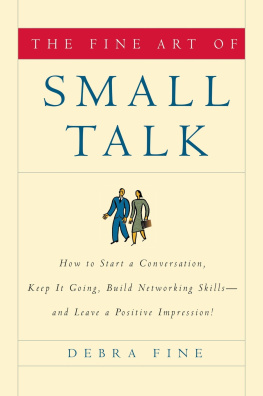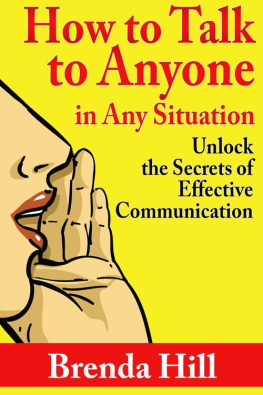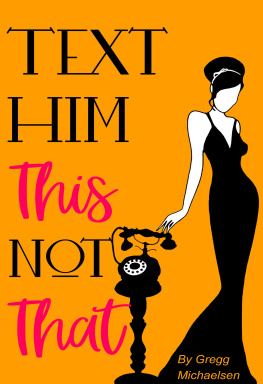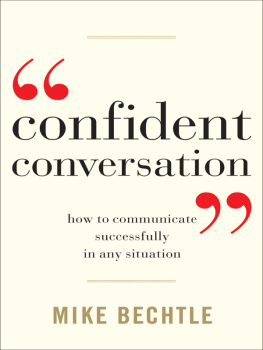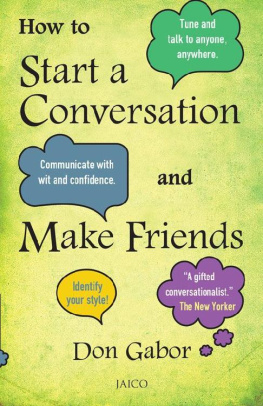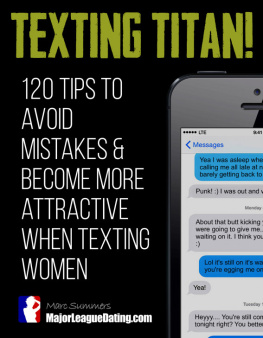Beyond Texting
The Fine Art of
Face-To-Face Communication
For Teenagers
Also By Debra Fine
The Fine Art of Small Talk
The Fine Art of the Big Talk
BEYOND TEXTING
The Fine Art of
Face-To-Face Communication For Teenagers
Debra Fine

Copyright 2014 Debra Fine
All rights reserved. No part of this book may be used or reproduced in any manner whatsoever without the written permission of the Publisher. Printed in the United States of America. For information address Canon Publishers,
Library of Congress Cataloging-in-Publication Data: 2013941019
Fine, Debra
Beyond texting: the fine art of face-to-face-communication for teenagers / Debra Fine
p. cm.
ISBN: 0988969602
1. Communication 2. Oral communication 3. Young Adult 4. Self -Help
ISBN: 13 978-0988969605
FIRST EDITION
Dedicated with love to the two who taught me the most:
Jared Fine Holst and Sarah Fine Holst and for Steve Tilliss who
makes my teenage years a small price to pay.
CONTENTS
Beyond Texting: The Fine Art of
Face-To-Face Communication For Teenagers
:
Why mastering conversational skills now will pay off later in life
:
Opening yourself up to others comes first
:
How to approach others and break the ice
:
Simple ways to keep the conversation going
:
Using open-ended questions to improve the quality of the conversation
:
Eight ways to kill a conversation
:
Tactful ways to end a conversation
:
How your body language silently communicates with others
:
How to impress others and remain true to yourself
:
Interacting with authority figures in ways that earn their respect
:
How to say no to peer pressure
:
How to quickly rid yourself of troublemakers
:
Eliminating the trauma of false friendships
:
Cutting off confrontations by choosing your words carefully
:
Balancing online tools with your offline life
:
Using digital tools to create in-person connections
:
Moving from the digital world to in-person romantic relationships
:
Putting your new skills to use out in the community
ACKNOWLEDGEMENTS
Huge thanks to the dedication and passion of Rachel Salter who brought her great writing skills to this project. Not only is she far closer in age to a teen, but her big heart better hears the beat of a teens drum. Her insight and contribution were the exact balance for whatever communication skills I offered. Patti Thorn, editor to the stars (and all of us that hope to be), always found the time to lend her expertise to this project. Despite a myriad of challenges she was with me for the entire journey. What author doesnt need a few magic tricks along with a dose of chicken soup wisdom? It is always there for me from Stacey Miller, my queen of PR who along with the man of my dreams Steve Tilliss sings a consistent chorus of Im a Believer whenever I mention a project. Lastly, thank you to all those who have reached out to me asking for a book for teens. I appreciate the kick in the butt.
INTRODUCTION
When I look back on my years as a teenager, I recall how uncomfortable I felt in so many situations. I trembled at the thought of having to stand in front of a class and give a ten-minute oral presentation. I retreated like a turtle into my shell anytime a boy tried to talk to me. I was terrified to go to parties and events where I didnt know many people, fearing Id end up standing in a corner alone or desperately trying to think of clever ways to strike up a conversation with a strangerwith little success. I wasnt necessarily shy; I just didnt have the right communication skills to give me the confidence I needed.
I wouldnt be at all surprised if you feel the same way. It almost seems as if communication has a secret codea complicated formula that isnt written anywhere, but one everyone else seems to understand. If only you, too, could crack the code, success would be automatic.
During this critical time in your life, youre just beginning to learn what to say and how to say it, as well as what not to say. Every word or action seems like it will shape your entire life. While this is not completely true, every word or action can lead to a conversation, which can lead to relationships that become the foundation of your life. One of the most valuable skills you can learn is the art of interacting and communicating with all kinds of people, from classmates and friends to parents, coaches and teachers.
Today, obtaining that skill is more challenging than ever. While the basic communication fears you have are probably similar to the ones teens had decades ago, technology has added many new twists. Facebook, Twitter, Instant Messenger and text messaging now play a huge role in how you communicate with your friends, family and others. These are great advancements in that they allow you to exchange information immediately and give you more choices in how to interact with others. But the more you rely on these devices, the more they can interfere with your comfort level when you communicate in person.
Think about it: Youre signed up for phone plans that give you unlimited text messages but only 200 talk minutes. You send birthday wishes, congratulations and thank you notes by tapping keys on a machine more often than relaying the message in person. You learn to display emoticons, but showing your emotions is another thing altogether. You can seamlessly connect to the web, but do you feel comfortable connecting with the person sitting next to you in class?
Digital communication is not going away; if anything, its bound to become more prevalent. In fact, new technologies for communicating are appearing all the time. So we all need to learn how to maintain the social skills we rely on to be active participants in the real world.
Thats where this book comes in. In Beyond Texting, I aim to give you the tools you need to successfully communicate with others in order to develop lasting, productive and meaningful relationships. On these pages, Ill teach you how to start a conversation, keep a conversation going and leave a positive impression. Ill teach you how to approach authority figures confidently and say no to peers, even when it seems impossible. And Ill show you how to balance technology-based and real-life interactions so you can set yourself up for future success.
Im not saying it will be easy. To improve your skills, you will have to take some risks. You may have to force yourself to talk to strangers youd rather avoid at a meeting or party, or apply for a job even though youre terrified of interviewing. You may have to say no to someone whos offering you a ride home after drinking, or convey your disappointment to a friend whos behaving badly. These are difficult interactions, but I promise if you can challenge yourself in these ways, youll soon develop positive practices that will be essential later in life as you start a career, establish important friendships and search for romantic relationships.
I know it can work for you, because it worked for me. After years of practice, Im no longer hesitant to strike up a conversation with a stranger at a party or to speak in front of a large group of people. In fact, I do this frequently for my work as a keynote speaker, talking to as many as 2,000 audience members at a time! Still, I often regret that it took me so long to develop these strong communication skills.
Next page

